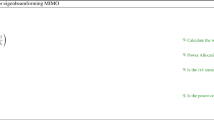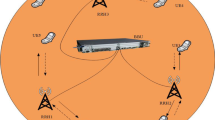Abstract
This paper is concerned with a wireless multiple-antenna system operating in multiple-input multiple-output (MIMO) fading channels with channel state information being known at both transmitter and receiver. By spatiotemporal subchannel selection and power control, it aims to minimize the average transmit power (ATP) of the MIMO system while achieving an exponential type of average bit error rate (BER) for each data stream. Under the constraints on each subchannel that individual outage probability and average BER are given, based on a traditional upper bound and a dynamic upper bound of Q function, two closed-form ATP expressions are derived, respectively, which can result in two different power allocation schemes. Numerical results are provided to validate the theoretical analysis, and show that the power allocation scheme with the dynamic upper bound can achieve more power savings than the one with the traditional upper bound.




Similar content being viewed by others
References
Telatar, I. E. (1999). Capacity of multi-antenna Gaussian channels. European Transactions on Telecommunications, 10(6), 585–596.
Kiessling, M. (2005). Unifying analysis of ergodic MIMO capacity in correlated Rayleigh fading environments. European Transactions on Telecommunications, 16(1), 17–35.
Jin, S., McKay, M. R., Gao, X., & Collings, I. B. (2008). MIMO multichannel beamforming: SER and outage using new eigenvalue distributions of complex noncentral Wishart matrices. IEEE Transactions on Communications, 56(3), 424–434.
Zheng, L., & Tse, D. N. (2003). Diversity and multiplexing: A fundamental tradeoff in multiple antenna channels. IEEE Transactions on Information Theory, 49(5), 1073–1096.
Lozano, A., & Jindal, N. (2010). Transmit diversity vs. spatial multiplexing in modern MIMO systems. IEEE Transactions on Wireless Communications, 9(1), 186–197.
Falou, A. E., Hamouda, W., Langlais, C., Nour, C. A., & Douillard, C. (2003). Finite-SNR diversity-multiplexing tradeoff for Rayleigh MIMO channels. IEEE Communications Letters, 17(4), 753–756.
Hayes, J. F. (1968). Adaptive feedback communication. IEEE Transactions on Communications, 16(1), 29–34.
Caire, G., & Kumar, K. R. (2007). Information theoretic foundations of adaptive coded modulation. Proceedings of the IEEE, 95(12), 2274–2298.
Palomar, D. P., Cioffi, J. M., & Lagunas, M. A. (2003). Joint Tx-Rx beamforming design for multicarrier MIMO channels: A unified framework for convex optimization. IEEE Transactions on Signal Processing, 51(9), 2381–2401.
Palomar, D. P., Cioffi, J. M., & Lagunas, M. A. (2003). Uniform power allocation in MIMO channels: A game-theoretic approach. IEEE Transactions on Information Theory, 49(7), 1707–1727.
Ordóñez, L. G., Palomar, D. P., & Fonollosa, J. R. (2009). Ordered eigenvalues of a general class of Hermitian random matrices with application to the perforamance analysis of MIMO systems. IEEE Transactions on Signal Processing, 57(2), 672–689.
Ordóñez, L. G., Palomar, D. P., Pagès-Zamora, A., & Fonollosa, J. R. (2009). Minimum BER linear MIMO transceivers with adaptive number of substreams. IEEE Transactions on Signal Processing, 57(6), 2336–2353.
Zanella, A., & Chiani, M. (2012). Reduced complexity power allocation strategies for MIMO systems with eigen value decomposition. IEEE Transactions on Vehicular Technology, 61(9), 4031–4041.
Xiong, F. (2006). Digital modulation techniques (2nd ed.). London: Artech House Inc.
Paulraj, A. J., Nabar, R., & Gore, D. (2003). Introduction to space-time wireless communications. Cambridge: Cambridge University Press.
Zhou, S., & Giannakis, G. B. (2003). Optimal transmitter eigen-beamforming and space-time block coding based on channel correlations. IEEE Transactions on Information Theory, 49(7), 1673–1690.
Rangarajan, A., Sharma, V., & Singh, S. K. (2003). Information-theoretic and communication-theoretic optimal power allocation for fading channels. In Proceedings of the IEEE international symposium on information theory (ISIT). Yokohama, Japan.
Rangarajan A., & Sharma, V. (2004). Achieving exponential diversity order in Rayleigh-fading channels. In Proceedings national conference on communications (NCC)
Premkumar, K., Sharma, V., & Rangarajan, A. (2004). Exponential diversity achieving spatio-temporal power allocation scheme for fading channels. DRDO-IISc program on mathematical engineering, IISc, Bangalore 560 012, India, Tech. Rep., TR-PME-2004-08. Available: http://www.pal.ece.iisc.ernet.in/PAM.
Sharma, V., Premkumar, K., & Swamy, R. N. (2008). Exponential diversity acheiving spatio-temporal power allocation scheme for fading channel. IEEE Transactions on Information Theory, 54(1), 188–208.
Ganesh, V., & Jalihal, D. (2007). Power allocation For MISO channel With co-ordinate interleaving technique. IEEE Signal Processing Letters, 14(5), 309–312.
Reddy, P. H. , Kumar, V. N. , Khan, M. Z. A. , & Srinivas, M. B. (2007). Optimal power allocation in space and time in MISO Rayleigh fading channels with peak to average power ratio constraint. 2007 IEEE Sarnoff symposium, 2007.
Khan, M. Z. A. (2008). Achieving exponential diversity in all fading channels. 24th Biennial symposium on commnunications, 2008 (pp. 274–277).
Müller, A., & Speidel, J. (2009). Achieving exponential diversity in wireless multihop systems with regenerative relays. IEEE interantional conference on commnunications (ICC’09), 2009.
Khan, M. Z. A. (2011). Achieving exponential diversity with spatio-temporal power allocation with imperfect channel state information. In Proceedings of national conference on communications (NCC), 2011.
Khan, M. Z. A. (2011). On achieving exponential diversity with partial channel state information in MIMO fading channels. In 7th International wireless communications and mobile computing conference (IWCMC), 2011 (pp.125–129).
Larrson, E. G., & Stoica, P. (2003). Space-time block coding for wireless communications. Cambridge: Cambridge University Press.
Li, G. Y., Xu, Z., Xiong, C., Yang, C., Zhang, S., Chen, Y., et al. (2011). Energy-efficient wireless communications: Tutorial, survey, and open issues. IEEE Wireless Communications, 18(6), 28–35.
Feng, D., Jiang, C., Lim, G., Cimini, L. J, Jr., Feng, G., & Li, G. Y. (2013). A survey of energy-efficient wireless communications. IEEE Communications Surveys and Tutorials, 15(1), 167–178.
Gupta, A. K., & Nagar, D. K. (2000). Matrix variate distributions. Boca Raton: Chapman and Hall/CRC.
Raleigh, G. G., & Cioffi, J. M. (1998). Spatio-temporal coding for wireless communication. IEEE Transactions on Communications, 46(3), 357–366.
Lebrun, G., Ying, T., & Faulkner, M. (2002). MIMO transmission overa timevarying channel using SVD. In Proceedings of the IEEE global telecommunications conference (pp. 414–418). Taipei, Taiwan.
Goldsmith, A. (2005). Wireless communications. Cambrige: Cambrige University Press.
Wang, Z., & Giannakis, G. B. (2003). A simple and general parameterization quantifying performance in fading channels. IEEE Transactions on Communications, 51(8), 1389–1398.
Lee, Y. H., & Bar-Ness, Y. (2003). Power adaptation for BPSK signaling with average and peak power constraints in Rayleigh fading channels. IEEE Transactions on Communications, 51(11), 1871–1876.
Zanella, A., & Chiani, M. (2008). The PDF of the \(l\)-th largest eigenvalue of central Wishart matrices and its application to the performance analysis of MIMO systems. In IEEE Golbal Telecommunications Conference (GLOBECOM), 2008.
Andews, L. C. (1998). Speical functions of mathematics for engineering. Oxford: Oxford University Press.
Alouini, M. S., & Goldsmith, A. (1999). Capacity of Rayleigh fading channels under different adaptive transmission and diversity-combining techniques. IEEE Transactions on Vehicular Technology, 48(4), 1165–1181.
Bölckei, H., Gesbert, D., & Paulraj, A. J. (2002). On the capacity of OFDM-based spatial muliplexing systems. IEEE Transactions on Communications, 50(2), 225–234.
Bölckei, H., Borgmann, M., & Paulraj, A. J. (2003). Impact of the propagation environment on the performance of space-frequency coded MIMO-OFDM. IEEE Journal on Selected Areas in Communications, 21(3), 427–439.
McKay, M. R., & Collings, I. B. (2006). On the capacity of frenquency-flat and frequency-selective Rician MIMO channels with single-ended correlation. IEEE Transactions on Wireless Communications, 5(8), 2038–2043.
Acknowledgments
This work was supported in part by the Scheme of Research Exchanges with China and India, the Royal Academy of Engineering of UK, the Specialized Research Fund for the Doctoral Program of Higher Education under Grant 20132125110006, and the open research fund of Zhejiang Provincial Key Lab of Data Storage and Transmission Technology, Hangzhou Dianzi University, under Grant 201401.
Author information
Authors and Affiliations
Corresponding author
Appendix
Appendix
The proof of Proposition 1
Since \(\overline{P}_b(i) \le \frac{\xi _i}{2} \frac{\overline{\lambda }_{\mathrm{out}}(i)}{\overline{\lambda }_{\mathrm{mea}}(i)}\), then it follows from Lemma 2 that \(\lambda _0(i)=\overline{\lambda }_{\mathrm{out}}(i)\). Furthermore, we can have
Substituting (29) into (60), we obtain
With respect to (61), we define
and
In what follows, we consider to derive (62) and (63), respectively. \(\square\)
From Lemma 1 in [36], the marginal p.d.f. of the \(i\)-th largest eigenvalue \(\lambda _i\) can be written as
where \(f_{\mathrm{min:}k}(x)\) denotes the p.d.f. of the smallest random variable considered in a subset of k random variables over the set of all eigenvalues, and is given by
With the help of the complementary incomplete gamma function \(\Gamma (q,x)\), thus we can obtain the desired result (43) after a simple derivation.
The derivation of (63) is similar, but involves a process employing the following special function \(\jmath _q(x)\) defined as [38]:
Finally, again making use of (64), we can easily obtain the desired expression of \(\rho _{\Delta }(\overline{\lambda }_{\mathrm{out}}(i))\) (44).
Rights and permissions
About this article
Cite this article
Yue, DW., Sun, Y. Transmit Power Minimization for MIMO Systems of Exponential Average BER with Fixed Outage Probability. Wireless Pers Commun 90, 1951–1970 (2016). https://doi.org/10.1007/s11277-016-3432-4
Published:
Issue Date:
DOI: https://doi.org/10.1007/s11277-016-3432-4




